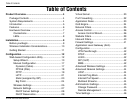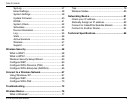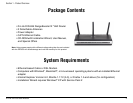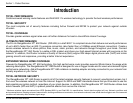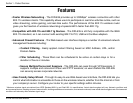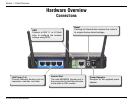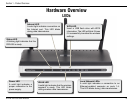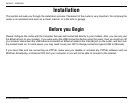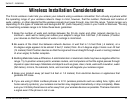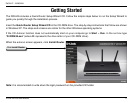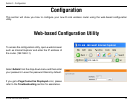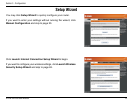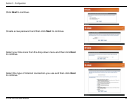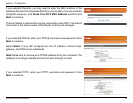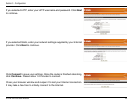
5D-Link DIR-635 User Manual
Section 1 - Product Overview
Introduction
TOTAL PERFORMANCE
Combines award winning router features and Draft 802.11n wireless technology to provide the best wireless performance
TOTAL SECURITY
The most complete set of security features including Active Firewall and WPA2 to protect your network against outside
intruders
TOTAL COVERAGE
Provides greater wireless signal rates even at farther distances for best-in-class Whole Home Coverage.
ULTIMATE PERFORMANCE
The D-Link RangeBooster N™ 650 Router (DIR-635) is a draft 802.11n compliant device that delivers real world performance
of up to 650% faster than an 802.11g wireless connection (also faster than a 100Mbps wired Ethernet connection). Create a
secure wireless network to share photos, les, music, video, printers, and network storage throughout your home. Connect
the RangeBooster N™ 650 Router to a cable or DSL modem and share your high-speed Internet access with everyone on the
network. In addition, this Router includes a Quality of Service (QoS) engine that keeps digital phone calls (VoIP) and online
gaming smooth and responsive, providing a better Internet experience.
EXTENDED WHOLE HOME COVERAGE
Powered by RangeBooster N™ 650 technology, this high performance router provides superior Whole Home Coverage while
reducing dead spots. The RangeBooster N™ 650 Router is designed for use in bigger homes and for users who demand higher
performance networking. Add a RangeBooster N™ 650 notebook or desktop adapter and stay connected to your network from
virtually anywhere in your home.
TOTAL NETWORK SECURITY
The RangeBooster N™ 650 Router supports all of the latest wireless security features to prevent unauthorized access, be it
from over the wireless network or from the Internet. Support for WPA and WEP standards ensure that you’ll be able to use the
best possible encryption method, regardless of your client devices. In addition, this RangeBooster N™ 650 Router utilizes dual
active rewalls (SPI and NAT) to prevent potential attacks from across the Internet.
* Maximum wireless signal rate derived from IEEE Standard 802.11g and Draft 802.11n specications. Actual data throughput will vary. Network conditions and
environmental factors, including volume of network trafc, building materials and construction, and network overhead, lower actual data throughput rate. Environmental
conditions will adversely affect wireless signal range.




